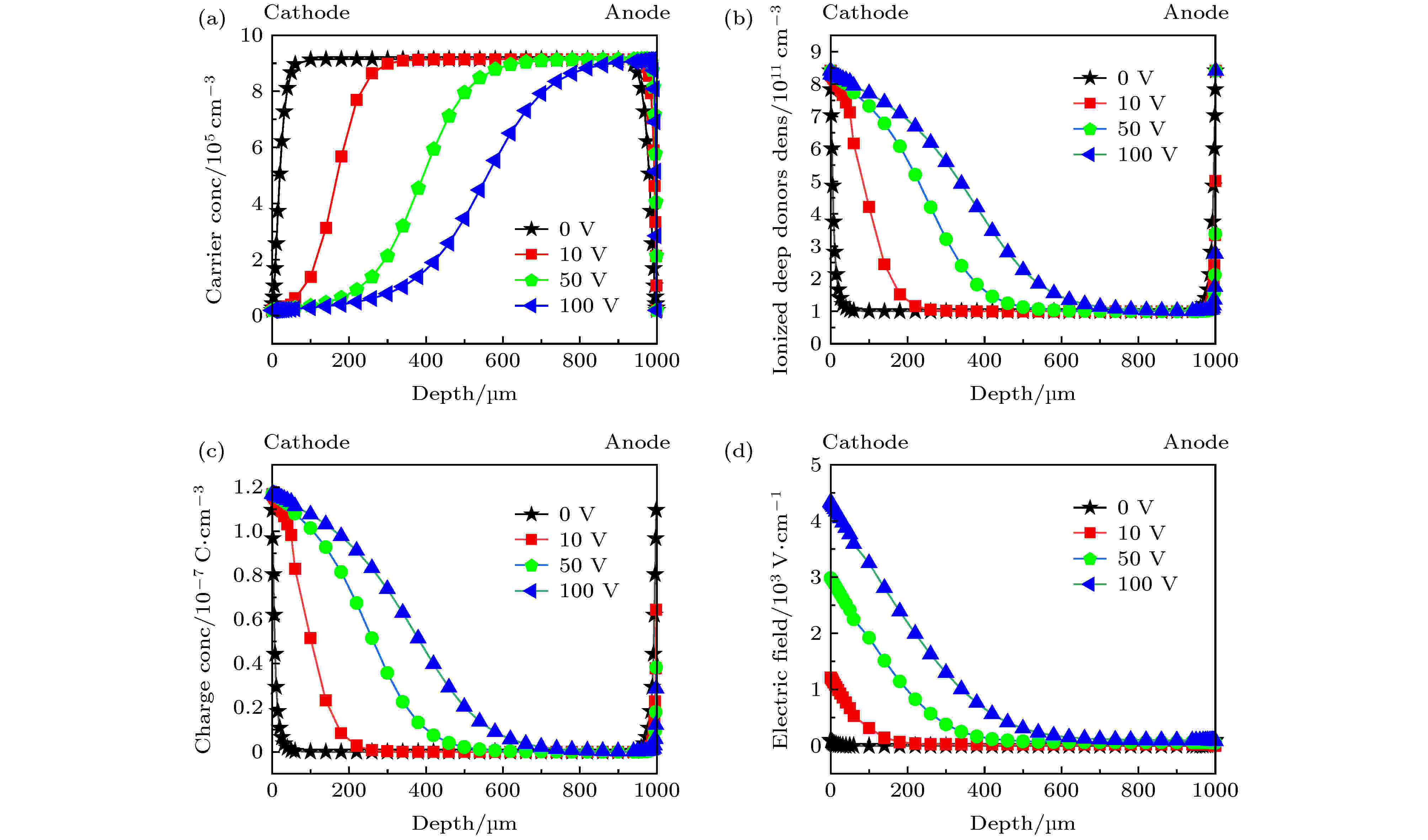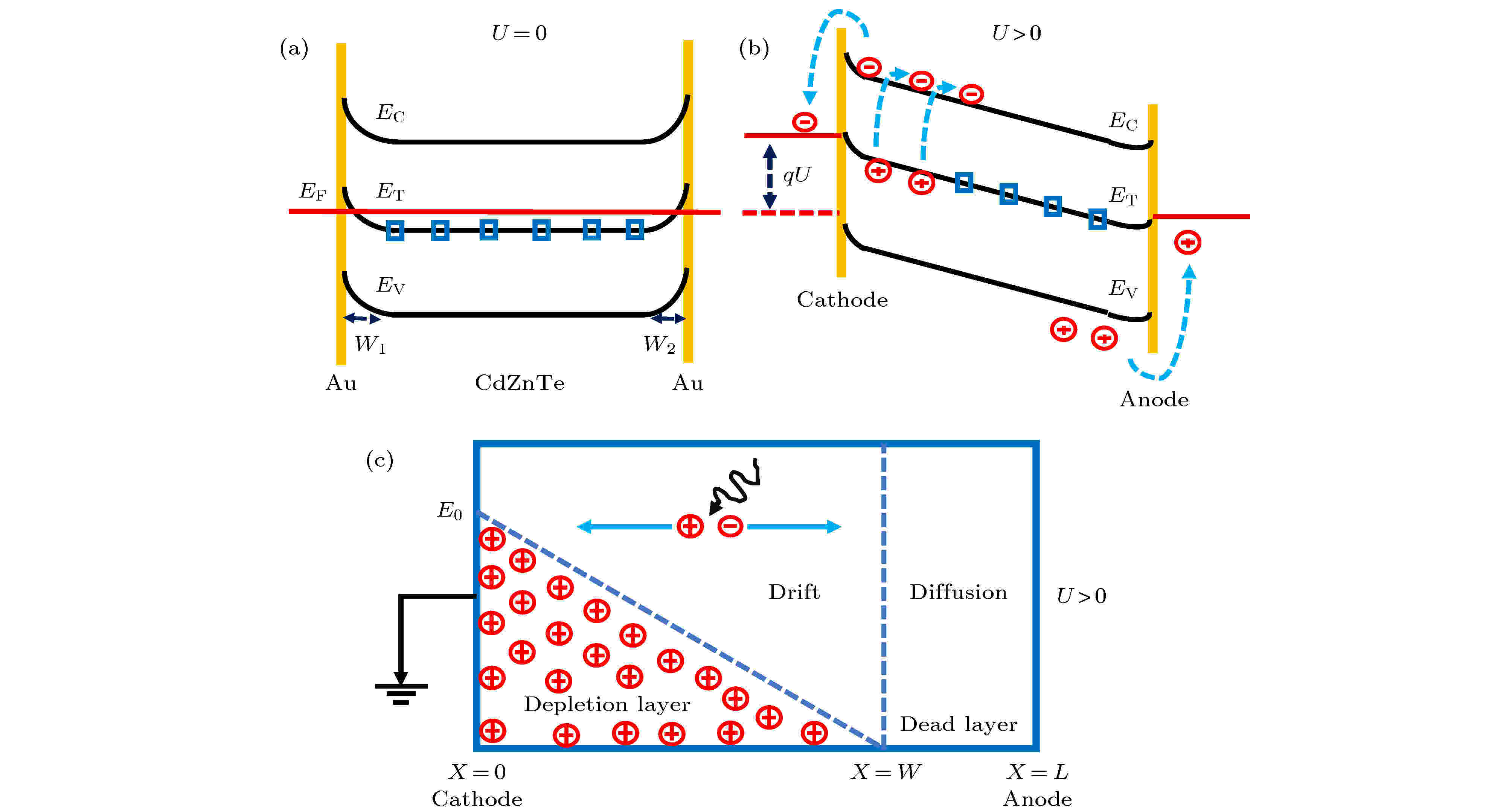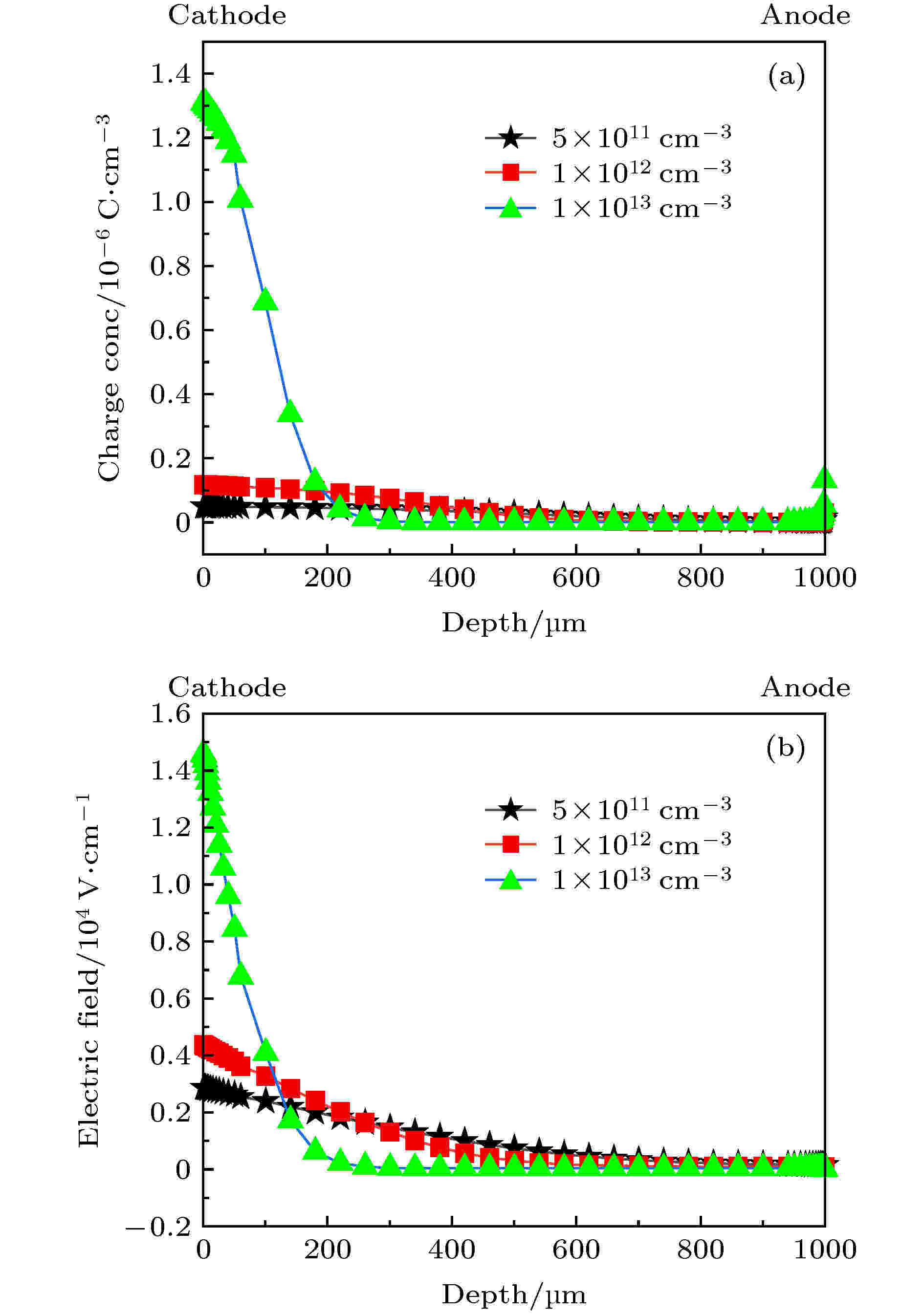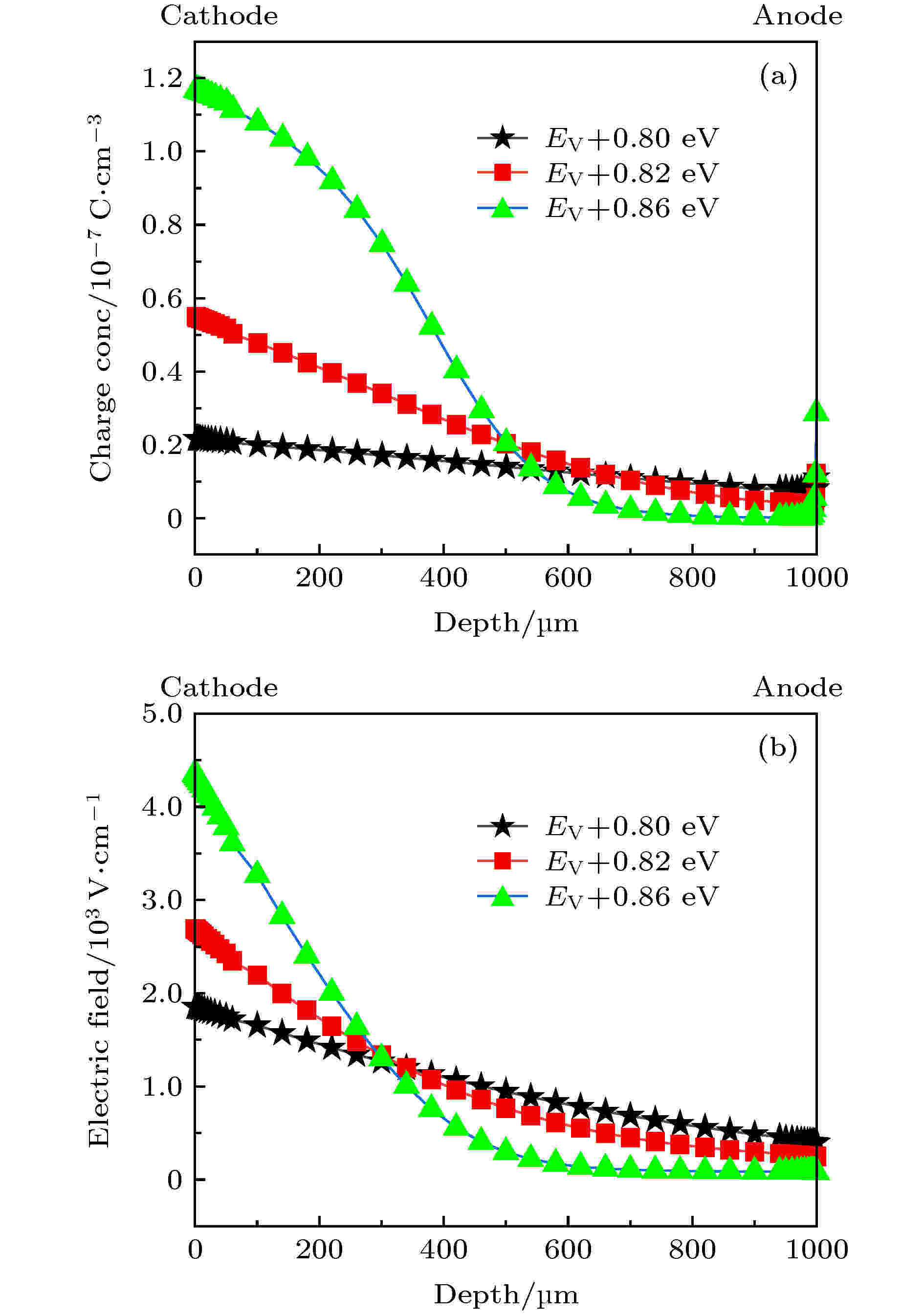全文HTML
--> --> -->然而, 生长态CdZnTe晶体中不可避免地存在大量的杂质和缺陷, 诸如Cd空位、Te反位原子、Te间隙原子以及它们和杂质原子形成的缺陷复合体等[8-10]. 这些结构缺陷容易形成载流子的陷阱, 在探测器工作时容易造成空间电荷积累, 引起电场畸变进而产生极化效应. 严重的极化效应甚至会使探测器彻底失效[11,12]. 近年来的研究集中于观测CdZnTe晶体内电场分布特性以及测试大剂量照射下器件性能响应. Cola和Farella[13]对CdTe晶体内部电场的研究表明, 空间电荷的积累会严重影响了电场分布, 进而降低了电荷收集效率. Li等[14]研究了CdZnTe探测器在大剂量X射线照射下光电流特性对探测器性能的影响. Bale等[15]、Camarda等[16]和Musiienko等[17]研究表明, 大剂量照射下积累的空间电荷会使探测器发生灾难性的故障. 对X射线成像系统来说, 空间电荷积累所引起电场的畸变是CdZnTe探测器面临的一大挑战[18,19]. 然而, 目前对于深能级缺陷如何影响空间电荷分布的微观机制讨论较少. 如何在引入深能级缺陷使晶体实现高阻的同时, 尽可能避免深能级缺陷带来的不利影响, 是值得探索的一个问题. 因此, 系统掌握深能级缺陷对空间电荷分布特性的影响规律对提高器件的性能有着重要的意义. Silvaco TCAD仿真软件可以得到半导体内部电学性能等相关信息, 在半导体性质与器件性能仿真方面有突出优势[20-22]. 由于晶体生长的复杂性且周期性长, 为了节约人力成本, 避免不必要的浪费, 本文采用Silvaco TCAD软件对CdZnTe晶体空间电荷分布等性质进行仿真, 探究深能级缺陷对空间电荷的分布以及内电场分布特性的影响规律, 从而揭示了深能级缺陷对器件性能的影响. 仿真结果将对CdZnTe晶体生长及成像器件的制备提供一定的理论指导.

 图 1 (a) Au/CdZnTe/Au器件结构示意图; (b) CdZnTe晶体内缺陷能级分布图
图 1 (a) Au/CdZnTe/Au器件结构示意图; (b) CdZnTe晶体内缺陷能级分布图Figure1. (a) Schematic diagram of Au/CdZnTe/Au device structure; (b) distributions of defect energy levels in CdZnTe crystal.
| 介电常数 | 300 K时禁带宽度/eV | 300 K时导带密度/cm–3 | 300 K时价带密度/cm–3 | 电子迁移率/ cm2·V–1·s–1 | 空穴迁移率/cm2·V–1·s–1 |
| 10.9 | 1.6 | 9.14 × 1017 | 5.19 × 1018 | 1000 | 100 |
表1CdZnTe晶体的基本参数
Table1.Basic parameters of CdZnTe crystals.
| 类型 | 位置/eV | 浓度/cm–3 | 电子俘获界面/cm2 | 空穴俘获界面/cm2 | 简并度 |
| Donor1 | Ev + 0.86 | 5 × 1012 | 3 × 10–14 | 3 × 10–15 | 2 |
| Donor2 | Ev + 0.86 | 1 × 1012 | 3 × 10–14 | 3 × 10–15 | 2 |
| Donor3 | Ev + 0.86 | 1 × 1013 | 3 × 10–14 | 3 × 10–15 | 2 |
表2深施主能级的基本信息
Table2.Basic information of deep donor energy levels.
3.1.深能级缺陷对电阻率的影响
不同深能级缺陷下仿真的CdZnTe晶体的电阻率结果如表3所列. 与不存在深能级缺陷的晶体相比, 深能级缺陷的加入会增大晶体的电阻率. 其原因是深施主去补偿多余的浅受主能级, 使载流子的浓度降低了, 费米能级也更靠近禁带中部位置, 从而使得电阻率增大[25]. 而随着深能级缺陷浓度不断增加, 晶体的电阻率会随着该深能级缺陷的浓度增大而减小. 当深施主缺陷(Ev + 0.86 eV)浓度为5 × 1011 cm–3时, CdZnTe晶体的电阻率达到1.50 × 1010 Ω·cm, 满足探测器级CdZnTe晶体的电阻率要求.| 能级类型 | 位置/eV | 浓度/cm–3 | 电阻率/Ω·cm |
| 无深施主能级 | — | — | 6.08 × 105 |
| Donor1 | Ev + 0.86 | 5 × 1011 | 1.50 × 1010 |
| Donor2 | Ev + 0.86 | 1 × 1012 | 6.66 × 109 |
| Donor3 | Ev + 0.86 | 1 × 1013 | 6.05 × 108 |
表3不同深能级缺陷浓度下CdZnTe晶体的电阻率仿真结果
Table3.The resistivity of CdZnTe crystals at different deep energy level concentrations via simulation.
2
3.2.深能级缺陷对空间电荷分布特性及器件性能的影响
为了进一步研究深施主能级对CdZnTe晶体内部空间电荷以及内电场分布特性的影响规律, 本文选择深施主缺陷能级位置为Ev + 0.86 eV, 浓度为1 × 1012 cm–3条件下进行仿真, 其仿真结果如图2所示. CdZnTe晶体内部不同偏压下载流子浓度分布规律, 如图2(a)所示. 当外加偏压为0 V时, Au与CdZnTe界面处的载流子浓度低于体内的载流子浓度. 结合热平衡条件下Au/CdZnTe/Au的能带图(如图3(a)所示)可知, 当金属Au和n型CdZnTe晶体接触时, 因为金属Au的功函数大于半导体CdZnTe的功函数, 电子从半导体向金属流动, 金属的一侧聚集负电荷, 而半导体的一侧聚集正电荷. 积累的正电荷从半导体表面向内部延伸一定的厚度, 形成空间电荷区. 亦即Au与CdZnTe接触界面处存在一定的载流子耗尽区, 使得这部分电子的浓度低于CdZnTe晶体体内电子浓度. 与此同时, 空间电荷区的存在形成内建电场, 其电场的方向由半导体指向金属, 因而造成一定的能带弯曲. 随着外加偏压的增大, 晶体内载流子的浓度呈现出不均匀分布趋势. 这与外加偏压下Au/CdZnTe/Au能带倾斜有关. 如图3(b)所示, 当外加偏压大于0时, 由于外加电场的作用, Au/CdZnTe/Au能带发生由阴极向阳极逐渐倾斜的趋势, 从而使器件内载流子的浓度呈现不均匀分布. 图 2 不同偏压下的Au/CdZnTe/Au器件仿真结果 (a) 载流子浓度分布; (b) 深施主的电离浓度分布; (c) 空间电荷浓度分布; (d) 内部电场强度分布变化规律
图 2 不同偏压下的Au/CdZnTe/Au器件仿真结果 (a) 载流子浓度分布; (b) 深施主的电离浓度分布; (c) 空间电荷浓度分布; (d) 内部电场强度分布变化规律Figure2. Simulation results of Au/CdZnTe/Au device under different bias voltages: (a) Distribution of carrier concentration; (b) density of ionized deep donors; (c) distribution of space charge concentration; (d) distribution of internal electric field intensity.
 图 3 Au/CdZnTe/Au器件内能带和内部电场分布示意图 (a) 热平衡的Au/CdZnTe/Au能带结构图; (b) U > 0的Au/CdZnTe/Au能带结构图; (c) 内部电场分布示意图
图 3 Au/CdZnTe/Au器件内能带和内部电场分布示意图 (a) 热平衡的Au/CdZnTe/Au能带结构图; (b) U > 0的Au/CdZnTe/Au能带结构图; (c) 内部电场分布示意图Figure3. Energy-band diagram and internal electric field distribution in Au/CdZnTe/Au device: (a) Au/CdZnTe/Au energy-band diagram in thermal equilibrium; (b) Au/CdZnTe/Au energy-band diagram under U > 0; (c) schematic diagram of internal electric field distribution.
载流子浓度的改变直接影响深能级的电离浓度[26]. 图2(b)为不同偏压下, 深能级电离浓度的分布图. 晶体中深施主能级总浓度为1 × 1012 cm–3. 根据图2(b)仿真结果显示, 在热平衡下晶体内部已电离的深施主能级浓度约为1 × 1011 cm–3, 即大概有10%的深施主能级发生了电离. 与此同时, 根据仿真结果可得, 热平衡下晶体费米能级位于Ev + 0.9 eV, 深施主能级的位置为Ev + 0.86 eV. 因此, 热平衡下, 费米能级处于深能级上方, 深施主能级发生了部分电离. 未电离的深施主能级被电子所占据着, 呈现中性态. 其能带示意图如图3(a)所示. 由图2(b)可知, 晶体内阳极附近的区域, 同一个位置的深施主电离浓度随着外加偏压的增大而减小, 而其余的区域, 同一个位置的深施主电离浓度则随着外加偏压的增大而增大. 这可能与外加偏压作用下Au/CdZnTe/Au能带倾斜有关, 其趋势如图3(b)所示. 在倾斜的能带中, 深能级处于费米能级上方, 意味着深能级被电子占据的概率下降, 则深能级缺陷倾向于发射电子, 即深能级发生电离. 深施主能级电离后留下不可移动的正电中心, 聚集产生空间电荷区, 如图3(c)所示. 因此, 在外加偏压作用下, 晶体内空间电荷浓度分布也呈现阴极到阳极逐渐减小趋势, 且晶体中的空间电荷浓度随着外加偏压的增加而增大. 原因是晶体内部的空间电荷主要是来源于深施主能级的电离后的正电中心. 即外加偏压增大, 使得能带倾斜越厉害, 从而深施主电离的概率越大, 其空间电荷浓度也就越多. 由图2(c)可知, 在热平衡条件下空间电荷区约为50 μm. 当电压为100 V, 几乎整个探测器的体积都受到正空间电荷的影响. 与此同时, 随着外加电压的增大, 能带倾斜越厉害, 此时阳极区域的势垒不断下降. 因此, 阳极区域的空间电荷浓度随着外加电压的增大而减小.
器件内部空间电荷与电场关系满足如下泊松方程式:





综上, 外加电压时, Au/CdZnTe/Au器件整体的能带结构呈现由阴极向阳极逐渐倾斜的趋势, 且界面处能带弯曲对载流子的收集存在一定的影响. 随着外加电压逐渐增大, 阴极势垒逐渐增大, 越有利于空穴从半导体进入阴极, 即空穴在阴极很容易被收集; 与此同时, 阳极势垒不断降低, 越有利于电子从半导体进入阳极, 即电子在阳极很容易被收集. 随着外加电压的增大, 耗尽区的区域逐渐增大, 死区的区域在不断的减小, 越有利于探测器对载流子的收集.
2
3.3.深能级缺陷浓度对空间电荷分布特性的影响
晶体内部深能级缺陷的存在会对内电场分布产生较大影响. 为了进一步了解不同浓度的深能级缺陷对空间电荷分布特性及器件性能的影响规律, 仿真了位置为Ev + 0.86 eV, 深施主能级缺陷浓度分别为5 × 1011, 1 × 1012和1 × 1013 cm–3的CdZnTe探测器在100 V外加偏压下, 其空间电荷分布及内电场分布, 具体仿真结果如图4所示. 由图4(a)可以看出, 100 V偏压下Au/CdZnTe/Au器件内空间电荷分布呈现由阴极向阳极逐渐减小的趋势, 且在阳极区域附近空间电荷浓度很小, 近乎为0. 在阴极附近区域, 空间电荷的浓度随着深施主能级的浓度的增大而不断增大. 由图4(b)可知, 当深施主能级浓度为1 × 1013 cm–3时, 内部电场变得陡峭. 在阴极区域电场强度很大, 且死区的区域最大. 这样的内部电场分布, 使得大部分的光生载流子(电子)无法通过漂移被阳极收集. 大量的电子在死区内只能靠浓度梯度扩散输运, 使得这部分载流子被晶体内部的缺陷俘获或者复合的概率急剧增大, 从而严重影响着探测器的载流子收集效率. 图 4 100 V偏压下Au/CdZnTe/Au器件不同深施主浓度下的 (a) 空间电荷分布特性; (b) 内部电场分布特性
图 4 100 V偏压下Au/CdZnTe/Au器件不同深施主浓度下的 (a) 空间电荷分布特性; (b) 内部电场分布特性Figure4. Space charge distributions (a) and internal electric field distribution (b) of Au/CdZnTe/Au devices with different deep donor concentrations under bias of 100 V.
2
3.4.不同位置的深能级缺陷对空间电荷分布特性的影响
为了得到不同位置的深能级缺陷对空间电荷分布特性及器件性能的影响规律. 本节仿真了CdZnTe晶体深施主能级缺陷浓度为1 × 1012 cm–3, 位置分别为Ev + 0.80, Ev + 0.82和Ev + 0.86 eV时, 且在100 V外加偏压下其内部空间电荷分布及内电场分布图, 仿真结果如图5所示. 由仿真得到深施主能级位于Ev + 0.80, Ev + 0.82和Ev + 0.86 eV时, 晶体的电阻率分别为6.85 × 1010, 3.19 × 1010和6.66 × 109 Ω·cm, 都满足探测器级CdZnTe晶体的电阻率要求. 由图5(a)可知, 在100 V的偏压下, 阴极区域附近的空间电荷浓度随着深施主能级位置的增大而增大, 而阳极区域和阴极区域的相反. 原因是深施主能级位置越接近于导带, 如上文所述在外加偏压作用时, 能带发生倾斜, 其深施主能级缺陷的电离浓度就越大. 且位置为EV + 0.86 eV的施主能级在阳极附近的出现空间电荷近乎为0的区域. 由图5(b)可知, 当深施主能级位置为EV + 0.80 eV时, 内部电场较平坦, 在阴极区域的电场强度最小, 且无死区的区域. 亦即在100 V的偏压下, 器件完全工作在耗尽层内, 则光生载流子就可以通过漂移的方式快速地到达两端的电极, 从而大大减小在输运过程中被俘获或者复合的概率, 进而提升了载流子的收集效率. 图 5 100 V偏压下Au/CdZnTe/Au器件不同深施主位置下的 (a) 空间电荷分布特性; (b)内部电场分布特性
图 5 100 V偏压下Au/CdZnTe/Au器件不同深施主位置下的 (a) 空间电荷分布特性; (b)内部电场分布特性Figure5. Space charge distributions (a) and internal electric field distribution (b) of Au/CdZnTe/Au devices with different depths of deep donor under bias of 100 V.


